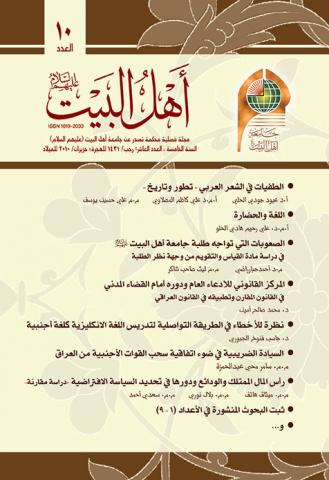Abstract
**Al-Tuffiyyat in Arabic Poetry – Development and History**
Al-Tuffiyyat refers to the poems that elegized Al-Hussain (peace be upon him), his companions, and his family, describing the suffering endured by his household and women after his martyrdom in the tragic Battle of Karbala, from its occurrence to the present day.
There is no doubt that these poems have gone through stages of development over time. How were these early poems structured? Were they fragments, short pieces, or full-fledged odes? What were their themes and general artistic and thematic characteristics? How did they evolve and develop throughout the ages, reaching their complete structural form?
This study aims to answer these questions by tracing the historical and artistic development of Al-Tuffiyyat poetry. It examines its early form as scattered fragments and short pieces before its gradual integration into poems praising or elegizing Ahl al-Bayt, as seen in Al-Kumayt’s **Hāshimiyyāt** and Di‘bil al-Khuzā‘ī’s **Tā’iyyah**. Later, with Al-Sharif Al-Radi, Al-Tuffiyyat gained independence as a distinct poetic form, with its structural features becoming more defined. Finally, it found its place in Arabic poetry across different eras, maintaining its expressive depth and evolving through various historical stages up to the modern age.
Al-Tuffiyyat refers to the poems that elegized Al-Hussain (peace be upon him), his companions, and his family, describing the suffering endured by his household and women after his martyrdom in the tragic Battle of Karbala, from its occurrence to the present day.
There is no doubt that these poems have gone through stages of development over time. How were these early poems structured? Were they fragments, short pieces, or full-fledged odes? What were their themes and general artistic and thematic characteristics? How did they evolve and develop throughout the ages, reaching their complete structural form?
This study aims to answer these questions by tracing the historical and artistic development of Al-Tuffiyyat poetry. It examines its early form as scattered fragments and short pieces before its gradual integration into poems praising or elegizing Ahl al-Bayt, as seen in Al-Kumayt’s **Hāshimiyyāt** and Di‘bil al-Khuzā‘ī’s **Tā’iyyah**. Later, with Al-Sharif Al-Radi, Al-Tuffiyyat gained independence as a distinct poetic form, with its structural features becoming more defined. Finally, it found its place in Arabic poetry across different eras, maintaining its expressive depth and evolving through various historical stages up to the modern age.
Keywords
Al-Hussain
Al-Tuffiyyat
Arabic poetry
elegy
Historical development
Abstract
الطفيات تلك الأشعار أو القصائد التي رثت الحسين (عليه السلام) وأصحابه و أهل بيته ووصفت ما جرى على عياله ونسائه من بعد استشهاده في واقعة الطف الأليمة منذ حلولها إلى الآن.
ولا ريب في أن هذه الأشعار مرَّت بمراحل تطورت خلالها؛ فكيف كانت تلك الأشعار أ كانت نتفا أو قطعا أو قصائد، ما هي موضوعاتها وخصائصها الموضوعية و الفنية العامة، كيف تطورت وتنامت على مرِّ العصور و استكملت مفاصلها البنائية ؟
وقد تكفل البحث بالإجابة عن هذه الأسئلة ورصد التطور التاريخي الفني لها منذ بداياتها على شكل نتف وقطع ومن ثمَّ وتبلورها ضمن قصائد مدح أهل البيت أو رثائهم كالذي نجده في هاشميات الكميت وتائية دعبل الخزاعي ومن ثمَّ استقلالها على يد الشريف الرضي ووضوح مفاصلها البنائية و أخيرا أخذت مسارها في الشعر العربي حتى العصر الحديث وعبرت عن مراحلها التي مرت بها.
ولا ريب في أن هذه الأشعار مرَّت بمراحل تطورت خلالها؛ فكيف كانت تلك الأشعار أ كانت نتفا أو قطعا أو قصائد، ما هي موضوعاتها وخصائصها الموضوعية و الفنية العامة، كيف تطورت وتنامت على مرِّ العصور و استكملت مفاصلها البنائية ؟
وقد تكفل البحث بالإجابة عن هذه الأسئلة ورصد التطور التاريخي الفني لها منذ بداياتها على شكل نتف وقطع ومن ثمَّ وتبلورها ضمن قصائد مدح أهل البيت أو رثائهم كالذي نجده في هاشميات الكميت وتائية دعبل الخزاعي ومن ثمَّ استقلالها على يد الشريف الرضي ووضوح مفاصلها البنائية و أخيرا أخذت مسارها في الشعر العربي حتى العصر الحديث وعبرت عن مراحلها التي مرت بها.
Keywords
الطفيات، الرثاء، الحسين، الشعر العربي، التطور التاريخي
